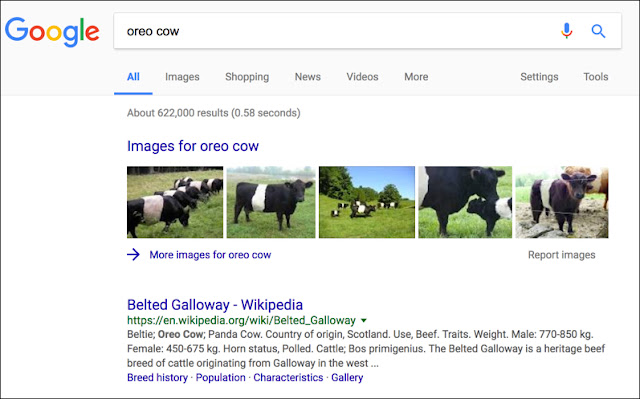Simple really is best.
The key getting really good at searching is to keep a very open mind about what works–because what works best will change over time. And sometimes, the simplest approach often works.
Let’s take a look at how I searched for these Challenges…
1. What kind of beast is this? (And what’s the simplest search that will get you the answer?)
When I saw this cow standing in a field, my first thought was (and I’m not making this up) “That looks like an Oreo cow!”
So, as silly as it sounds, my first query was:
[ Oreo cow ]
And here’s what I found out…
Lo and Behold–it’s a Belted Galloway cow. It originated from western Scotland and can thrive under pretty sketchy conditions (low forage, wet, windy–a Scottish climate).
I love the description in the Wikipedia article: “..Belted Galloways are primarily raised for their quality marbled beef, although they are sometimes milked and purchased to adorn pastures due to their striking appearance.”
WHY did this seemingly hyper-simple query work? Because, like me, many people have had the same instant response to seeing these cows. As a consequence, they’ve written about “Oreo cows”–it’s the “folk way” to talk about this breed of cattle. And sometimes… simple is best. If you have an immediate reaction to something (as a descriptive word or phrase), remember that, because you probably aren’t the only person to have that reaction.
2. When it snows gently at night (as it did many nights when I was a grad student in Rochester, NY), you can see the most beautiful display of lights around the parking lots. What is this phenomenon called?
Again, here I took the simplest possible search:
[ towers of light in snow ]
and I quickly found the Wikipedia entry for Light Pillars, which are caused by lights reflecting off atmospheric particles (dust, rain, snow) to form lines of light extending from the source.
In the particular case of snow, the snow crystals causing the pillars are usually flat, hexagonal plates. They tend to fall more-or-less horizontally, which makes them reflect light in a consistent way. As they fall, the crystals are perturbed by turbulence, causing the reflection (i.e. the light pillar) to become elongated into a column above and below the light source. The color of the pillar is the color of the light source, which sometimes is a fantastic scene.
This really is a beautiful effect. Here’s another image from Wikipedia:
 |
| Light pillars in snow. P/C Wikipedia (photographer: Timmy Joe Elzinga) |
3. And lastly, many animals have this strange extra eyelid. What’s it called?
 |
| P/C Wikipedia. The nictitating membrane of the masked lapwing. |
Once again, the simplest search is:
[ extra eyelid ]
and you’ll quickly learn that this is a nictitating membrane that occurs in lizards, fish, sharks, and some mammals.
Wikipedia on nictitating membrane: “The nictitating membrane (from Latin nictare, to blink) is a transparent or translucent third eyelid present in some animals that can be drawn across the eye for protection and to moisten it while maintaining vision. Some reptiles, birds, and sharks have full nictitating membranes; while in many mammals, a small, vestigial portion of the membrane remains in the corner of the eye. Some mammals, such as camels, polar bears, seals and aardvarks, have full nictitating membranes.”
Hope you enjoyed this search. It was great fun to put together…
Search Lesson
Well, the title says it all: Simple is best. Remember that mostly what you’re trying to do is to find language that other people would have written about your search topic. And if you look at something and have an immediate response, that’s probably a great search phrase.
Or, if you see something that’s probably got a very specialized technical term (think “nictitating membrane”), there’s certainly a simpler way to describe it. Use that simpler query to find the specialized term, then you can start to learn more by using the correct, very specific term.
So if you saw an animal like this:
What would be your first reaction? (No… it’s not photoshopped… it’s real.)
Probably something like “that looks like it’s half of a zebra!” Go with that as your query:
[ animal that’s half zebra ]
and you’ll do really well.
Scheduling
As you probably noticed, the past two weeks haven’t followed our usual Wednesday-Challenge followed by a Monday-Answer. This is because I’ve been doing a lot of traveling, lecturing about SearchResearch at various places around the country. This week I gave 4 lectures and 3 classes, which tends to disrupt my schedule a bit.
Warning: The next month or so will be like this as I travel to Zurich, Switzerland, to teach a course at the University there.
So stay tuned. I’ll keep sending out the Challenges (and I’ve got a couple of really good ones schedule), followed by the Answers–but they might be skewed a little from the Monday/Wednesday cycle.
Stick around. I’m sure to have at least a few Swiss Challenges!
Search on.








